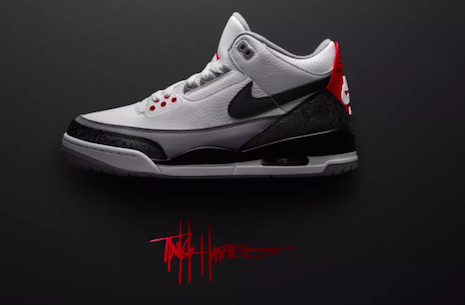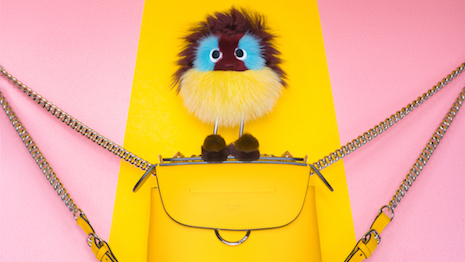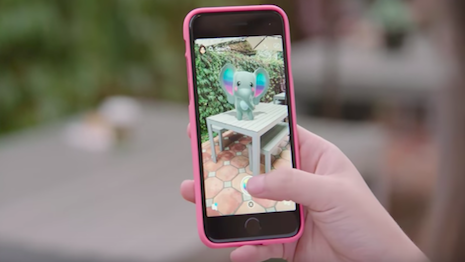Social platform Snapchat has taken on a surprising new element of its business model with the addition of a new ecommerce push.
In the wake of controversial changes from a new user interface update and a small but significant exodus of influencers, Snapchat has made the surprising turn to ecommerce with the drop of Nike’s Air Jordans through the platform. If this is a route that Snapchat continues down, it may see more influence from the luxury world as well.
Ecommerce drops
Snapchat has had a tumultuous few weeks. Piling onto its ongoing competition with Instagram, which has successfully co-opted Snapchat’s Stories features, the platform also recently rolled out a big redesign to the application, which was met with a less than stellar reaction.
After users revolted and created a massive petition to reverse the update, which became so large that Snapchat was forced to respond. One of the main criticisms was that it strained the relationship between users and influencers on Snapchat.

Snapchat users could buy the new Air Jordans directly through the app. Image credit: Nike
But it seems that Snapchat may be moving away from advertising as a business model in favor of mobile commerce.
At an event hosted by Nike on Feb. 18, attendees were directed to scan a code through Snapchat to get a look at the new Air Jordans. From there, users could purchase the shoes directly through Snapchat.
This move has the potential to significantly impact the way that Snapchat does business, providing opportunities for exclusive and limited-run products to be purchased directly through the app and letting Snapchat work with brands directly rather than through ads or influencers.
A competitive alternative
Snapchat’s move towards commerce is surprising given the efforts the platform has gone to recently to court more advertisers.
For one, Snapchat is testing unskippable advertisements, something that has never appeared on the platform before, as well as moving content so that it is not exclusive to the application. As luxury brands and influencers increasingly move to Instagram, Snapchat is left to figure out how to keep advertisers without alienating users (see story).
Snap’s competition with Instagram is well known and the popularity of Instagram Stories, which was directly based on Snapchat Stories, is a sore spot for the platform. Even Google has gotten in on the co-opting of Snapchat Stories with AMP Stories.
AMP Stories allow Google search users to see a carousel-style slideshow of content from some of the partner publishers for this product, including Meredith, Condé Nast and the Wall Street Journal. The step marks the continued transformation of how content is consumed on phones, with Stories becoming a major player across all of the big digital platforms (see story).
Luxury brands have previously linked Snapchat content to a purchase path.
Recently, Italian fashion house Fendi tapped Snapchat for an activation of a campaign centered on “bag bugs,” small creatures who could be controlled through the use of Snapchat’s Stories feature.

Fendi's bag bugs. Image credit: Fendi
As they are viewing a story, consumers can use the organic tap function to advance to the next scene, allowing them to feel as though they are controlling the animation. When the story ends, consumers will be prompted to swipe up to navigate to Fendi’s ecommerce site, where they can shop the collection (see story).
In the future, it is likely that Snapchat will push for more luxury brands to make use of its ecommerce abilities in an attempt to differentiate itself from the competition.
{"ct":"XkgDmDeL7UoW5abh7O7I0pVWCOv\/RGTX70n9Qr2VI3lh6KI01rM2Z4BdGzRUNMc3aAtpVadRHMc7\/Pk64tkdhZTUXxwW7OdtSL2NGFRbsm7GWKAjS0ltfDLmrMfpn5C+bRASMgMMV3uOadnyslkpctFYYWlWf2zyETLBxbqAOSudrnF3LtNod9cyE2JWgDTosB3JxBIoZR2Q9xhpDwCfG9GZElw\/2CXBP0eSyhydf\/2J\/MrEA6SKgHluu4gUt+cxBWKazCjc9wGH+co4NC1bUwJHWh\/CpukgJystBE6qPAGcPcmOMOez1PTM82c3Ktqk4DCJZmdFdJPUdhGa9QRbCb4djr\/gBK8ZNFp1pm5MOvP9rUTU6hTV6XRG0F1fajEvp5f027TLP45o3LauGfczGQ02Y4nhZpANQFdre2hAz\/mX\/fh2uZThr2fiB9+9+O1K62fs31pjUlyDmX087rLD5aQ4dNOvvfOjcqHNtMVyW+zWOkaKSMKXymtbFiXSRMsfLmDcJ8eCMJ8PAM7qn3AK+qx7g9\/kbbHb0T7wVuwVMrZrzR+uvPufivHYkGJnuyRkxFjF9Xg5R8w\/5MaAggRQmTa2T5\/hPojtXV5umYAHB7+U+qci5GHRfZ6PPUq9ki1tXCzoJA7eVT1ksbE9PLuT70XQ7LbKnlICdxuqqaBxNnP5xCUCfHQ\/J0BsQgKqrx9ShzntDg5\/iFHmLQ\/Mha6UTeKBNr1XBjSv8obbvXiP55OvvF6AwdE5YzLF5BJxwBvHNMC9X4xVMvQIOT2h6E4Lx6+mOeOMsNSQbgiFBtK00yMn5Z4RdQQR38S4WBfsticjk6pOkY7aUyzSPPZTj57OXrhswAk7JK7f\/FcvVdG4asE8jEHisUIacuH++IfMLAH2IVMvIDQn6pPO\/TRbR+ipvPNtQpHI5kRPqbnzpVXwiqLwavmeECcrann4tHg74gNdjlT9gBK+RbnUr9X+awhi40PIjVLvsPGO9\/yeVBE9nyNEoEsXLR3g2fDaY9V25XBTvChD9mDHWtRc52E4M2fsoTonb\/C87\/fu61SJ+aa5hQOjXFO7iGTPIkoV8QzAHuJIuceLpqWFH8CeBKAU+CAUJ9BfBiuiYgcVk6P9tsvrlM71RH6G0SlZ5lpv+2GqvqK6MpQFFfl6mnYJbtCkt5jbbGdSp52GxXjIfGKYLQH+Rz\/OxwWWPT2wDJuJs+nYmK+9BWYtwtd\/XMBlMDxk7HTBQUnpXLsmdJ0lgfJaRxGXhaCm55n3hz8dc8tTzOgu0ueDeq3T8wm6HiNfjmoxRucUuews1tbJ77DNZVcu0UOPhFdVkld2SwAcwOwQM2pb2BYPbs\/1AEN3Zwj27rDtFZNyV6sukF3+VZ4mitIh6mDO0B+OV7bpM+aQd6OgTssQGUrYWhwQQNepH+xG9ndT38FwdNo1L0CJpVw5G6aYk3tmMg3MYlBlhyUHlwkZq1t85ZZG59GX5JUfj6NQBal8b3wCJtuUzATCA1JuL8R9+3vIfhcrlyzzZajYHYhyZY\/FyQFbznf+o6M0\/Yfnczy7cQka2z\/k8wMm6v0KzTxXvxqQHcMqwg5rw2aPxaSI5HFrRfFVyGXlvU+TTuRTAYTXKsFV79CzFIRFP7QhTgifHH44h8pKIpeiX9FUdr6sT6E+GDjfVRE82TsFaifTNPeInJQq7Zkkrgk\/W1Xvh\/4d0Zmd0DBmp8oQvOfNYWT34C0k6dUUF4EHYqaBwrAWAz4Gg8L7e2AZHkeDwvmkqdGoiWpl57uiWvpNjJ8ILtz+oc4ObB+GGUm4Gnjnh\/fiAP6OQuxd4AkjGaJDD2nCYLfcGf4lxephBJV+kdZKrDdHYtUzZI8zrNxXugr0KTCyT0WuNV6WACcNln2a3AebCpEIjtfnt7aOjnhheVSt48naHGAevxVRbSF6S\/TQEY9LH+dsLEkfHtwjHISB0KAJ5VRvrErcPohECqn2JxMOM50aOqhWxDhuYpO21pslVnsvR10JRJTC3gVuItNuNmCQOtYRpdSXH6ngyOzxuRQQ++qTKzDERuT\/fy26r0WPjuVoYhAfOIVPRR3WTvegAko2LuqTuQ3uD+oeMS6UgG3MI4MAvTXmTZ0hEvYUyGXonj5t27CFKAi0TTQ3G6phG9+BOt+ZpC86RS1Wc8DQobJuwWrPbK2Cu4\/RFX1mfC2B+jz1X4JilaVu4l3Tby7UB3F1EkWNTCYddwo2m4AF70y4acIgclIeqnyISbk+zZS7M7iY8FNLJM74oUxSwegwvmU4czQetv6iDoV8FNVTcdreT1jwX3crntLp0TiMAx3N9T0GK0O2pqBm4cd4pXJBdt82+qMFbYDOw\/tHGKm87xCLjjfidf\/f2bCMCND73ipXkJ2I4QFCjupMiR24SilH4w6QiYVxtJB52Qz\/TKcI\/b9kkS\/LJcV+HxXRXizpbx9vJG4PIerqKXRwfpijg8T8pPgEPNsuqg8e2nRfC7PNKzzMerGANVp8ANbAxZfnSGJII7hk721Vio1E+Q0OZhHSYjAbnjiLQC7mUuP5qLZTzHv\/hfrLMA5F\/bdyfMSFKvGsQA3B\/tZieX45PhETM7od3pOScWglm9UMrpo7OSMmA1YPYuE3NQ+Fy6E2d7bmcyAMqJSw4VyS+OzyFyt6KGOkg1Tw2DxXRD8jMZmSNQI2QB2NrZBFweZz2sT+NzTQ5FEfFcw4S3sKPbSw53eTVamG2pTWtzxrtUXddsbdLvHB9Tk8hCUc\/sLnvpZ3fmo5T\/tRoT7UvntdoKmfoLYTXi0QMoe4mAG7JZgnx3tr5TTM91k2ZwJjhDQ+gWLsqZDpbfbOC+L\/X\/wrpOw4xR2+9UhgeaqsjfJRLXm0iO5gugobMrS5tzpFtqgWj8SRtz9u42uPpWaMV8hs\/ENSpf4xNu7siPEosuPDQi57d+oszExbQ\/\/NwrY9zeEdoLz4mZVz6C7yGryNeEZYk7r5A3rGD+DNIbRBlBslSgTaDZtu6EIaJjvhd+kv2FJIpmdfB0P7CCv2bENTL2heRrbb6msVcaLzeEvMO8lbthZsEMfDDk4tU6BHe4Q7nbYO8BCXBeBiGohaZJ0CUIqaL5lnD8mrX0ex30Q3jf\/fDJwHFbzgpsE5h9H1WoRQUBYiAx\/pugjkx1DIJNRYIFsmPWxjIYdGC0b2QwNZck6FsPlLPUU2x1kjWSYe6WzCwCtd4M2LheF9IQL8GyPCBkmVupoz4QiF09h8KikI3fHGPBi2kpu3t0qpsmStVY3vw0hXKGo2uQ7efhFDqxUAtsLSXMRlE5cmVolMdGudWqUfDWfJDxqDg4gxK+En0jO6ZMDkB7dL9MmlHewv1\/09sX+DQfxARORRUUv8FY0KsKqgKZtPfI1FSbTqkPymtN2MuNmQFuZH+WBaSbZFOitNpmmwQE2q2XBfE4mei+ohM8DkiWo5SS\/2fZVYmBUi7IGT2gJanG\/N+lEGgE8JkQAE3w0yloe31kA6my4NFaJYskJcnXKOefQCGIal53qnOcWkt1szQXXEuaMgEIweuVkusjd+tFcB2svQ0PsTcm1H6OqJthfjVBLnyiocSDwaTPJdr+ofPCaKjvXIkpO9wy0NAdfjYnrghEx79\/74xT9RyY6Y\/bVzSunI7\/cq7uoMLpb88TiNWxOP5W7uqaacHvpe9uiIqKo6bqv2W4qWvDJJY9pL0ADkFotea6IaxkWpCOyY+3\/viAPVowjdQZ6rYok2xEWewfu3EdSQaifTb0iFxzLbHtYbq+w8OTgcAPgtbxE72BwnMBMzTquu4qlZBYjMtzgmFYmRsVBs0ulYt3cqkfLZPhL1hHhM0JhwuE10VvWiwfuKaOjArvNEK1tMYNcW6WFaELJZ48nykBoRsCNND3o41MO8f0ZZrwtrhyxnLp2qwqbLiXjVX5\/0SHAsN4ZvhPkfZ\/so\/PcdKHha53lSgtL8K+1cAvtCps63sijW8EmJcQ2\/ivADzosM7Moy59vCgFSqvitrBscgrTYYbHq6N3cr43GsFtcLLSZAvJJq2\/trAwnDNOOBacO9ER7guust+Qdhm\/JpYISYRYPvBfznEL9CCUFdjkYK3uoLlxMAW6xtRYlWh4eYkvLRewtbXrrPu4BlShQlsOnSajpGrXZgLzFKN6eRnNAQ93OeIVd2IMNcwMFWS1EOXxc\/VayLKCdUAnKzRbysGDW\/08COxZPBk22pfBj5p5t6vsRSpuLDm5Zxx43FnfDQpExo9BlBmzSVR0jJH\/R8V6qWhSaW7Er9MKhLM1PVrkcIyNBj0I4R\/+9n6Ltoluk03yfEFDLyD82WNUvGgcNKi72zlv7YGTVoRazwEwz+0lE+q866gJDAjKhbryB1u61CTtasJT0hSPt9BzOXUNIqKjlFxrEVA7OTkEQPeDLET9Vote4YhHtIHkIY1vsnyfdFrDmgWjVpouo9J6wtJVehpvgYj82dlKNH3gxZ8Gzfa\/NkavQT95evR4Ab4wJeg85bNCAGzi+PRqw9BlCR2P\/FLRV\/JYJPW\/k1NDTIzEhP83vE5hcjQq4tCIAYvfJ1sfH2qy0qq6OSgAKkZfakqiXF3ErtjVoaWXn2zFqpArFn7bVlQ4nt4DhJJEXjw7brWosKClSexY4AUCotC2D0gypyZojJuU25Y+utmYlA4QR1xEthtr037RAGFOW6plVpyFHrlC0q09a6l+8NaA9uuknspDd2goA2gmXV\/v\/OXMSXoXBHU8HWaSLJSAw4\/3\/BEAHHPkUw73Tbafy+MjR396eTTx33wQF9wJrY\/QCJFEulY1TFjcnwy3pZWKpveiYCZiCPz+50Atly0ibKurPdhSavIMcpwWbxPxqAyrZBvyl0hA8\/09vYpkYmEXMgr1UnjbDEpqTe6IFk5D\/lgx1+pQ02mjlXB0ny2O7WeYdZk88HYuv+w692zfVoN0BTF9PYNAxQULsZ+h7ij7milrGvPSjUtZmZLis0kZiub+2nweh2mLgB9WvPqMhx2WWxdizOxCGf\/HeSIEP1BZUz8t24ApwcAEb\/2bBUWxc5+IrOIDrKVVwy1j2m+VrOdjWF9CaCVA6uk\/0MSDTyCV\/OWtZYHE3zMXgsyQbT9yqfyg7aDoKIqtWYKTm\/4i5noBFJ9jHnlBRMtp89WN2rv47oo8wjNKzFrdTgh3NFnwbIA7\/RJZw+sG3vQoSQKxulLI4WX\/vsiXkQuaOIdx1MSrW13AW+g2ENNNC9sDJzFEBf8VNfDWC\/KUw9iWelwlozQfL+n9BLOT3GEpZ8hNDQcPuo5O3WnI04OWmFotFrXJWzvA02\/QwJpeg75E7FrBo7NlXeAu3Kdy971bJAZZI6\/BuI24nJUFbEtHaS8rIRgDojaCyn3zYufbaE188j3tFNrHWkrp\/0l4P5QE8jb+4uTa2uimd\/VuL4UXjTYa7efgZ6SaCIE7fZdgFcfd\/z35aUwFJhYinEllaT+oSj5NMfd8oWbazJv6m5ckI6P2ScQE9PUZOOLs2poQs7ZwLT3TOMiiweIAvd1VR46fOxpTsCYxi3aYskJAp\/eB6ooZs1esUtfzA\/9sUBx+YRQKC+5Iqi0ubE373HNXmMTAHU6ST7hZgP1nLzH4ZU5sBoKoEi8vH9Qt25FZ4goW1cus2eA3UKtzoLpHArxjnPYM6TQ+DyucsXiVoEbCkM3l3WhzfYvvmoR50CG8R2zfem2PYRphKySbX2eWdW9MSk9mO1R4qf7+5gdRkAweEWNG7xjSbLFAJKL0\/fausnBCoMWMwuzj5jGQUHXTui51ZaS0aQV7\/lslW2HbUcZvR3L\/SI+31BF4CVeKAcNe6\/gqjwKo6qCTq4HOiyF7mnAKQji9ZgIw\/\/ySygNoXZYmQK0n+K476Ac4dwfx4FuyXg\/zvrar\/ZLoKHdquVewEv1YKYu0oWlwo7yq3XyEaKZm91ziF93S+T6UwrWt\/LJhtLAIY7orAUnBZMeVCX0VRd65vu\/H1tMHwi1p\/uQx11vwrOW5nWl0oD+rDJOVcUit3xI5LiZhfz4AYoRPZTNgmOS4r37a9WNMRRQiETkM51FywfAkdGmglrVo5Ne8oU\/m7kEMAMAvRjunn3QF1VxLRq7ZHkhUsSrYsUJip8C+4HDGDmJIzJLNtiRU5tq5W53rkmeAhrbdCdzPTY6MJ4hvbdPSlbhfoWh0HJrBSFbF0hVDBXpGhDge+laVHcE3vwlUNxGV5xQz5nnp6FypsnjIKB7O5In+PC+uk+AuphNYMtwougmPQjcvWgjsr0bOLLKM47bqSDLlhmJl2yiCeWBR8ApGnisTRjqjTttTT1HAg0dRmd89ciHMrzu+ppieBkJb6lBtgBszY7zhYyb00TD69VCo+CJ\/6+wt\/66wPkVYlNNOI8ftXaT5JGMkXfW63k9Ngluha9wXV8FvwCA0a1AJX1E4ZYSGbh1rId0rAM8jzAmwnOLLNjcZUGLVIzw3iejeLJ6M+o8UfutuEwwZgP7mrVuUhRd8EcVMkVDAZQ7rJR47xWItWXKf1YRPoWK1u5Co+Hxl\/OrAmPLaZ90Di620DGGretzXYri8T5eUuyWH5FsY\/yOizOydVTgors4cEpDQUdMXget7ocJxj9URvNuWvan\/c+ZoLmjJMHf\/OkXsECxYRD4AX33ltUC\/NheoOPuldjFrXzIEn1FyncRhMYh9810uWA3FfPAOeWOPkRXHG8AbUOMjr3cD\/Xld5LJnMD+yW7\/I2xacYYGyHLFiFpLbIugWzloq\/2ttCTBuvLqLCK2eDo4Q==","iv":"4ef5b7c77e3f13dea8c1cecf92093b11","s":"e2109f67958b115e"}

 A surprise ecommerce partnership with Nike could signal a new direction for Snapchat. Image credit: Snap
A surprise ecommerce partnership with Nike could signal a new direction for Snapchat. Image credit: Snap